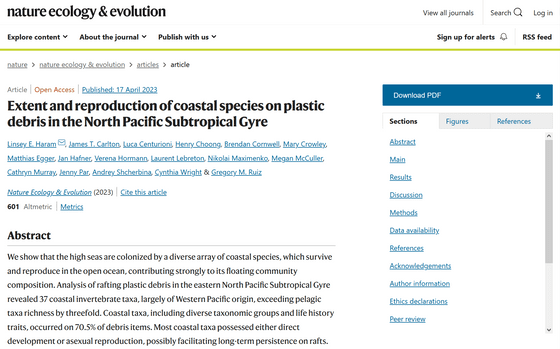Originally, it turned out that creatures living on the coast attached to garbage drifting in the sea and constituted a new ecosystem

Research has revealed that coastal organisms that normally cannot go out into the open sea are gathering in
Extent and reproduction of coastal species on plastic debris in the North Pacific Subtropical Gyre | Nature Ecology & Evolution
https://doi.org/10.1038/s41559-023-01997-y

The Great Pacific Garbage Patch Is So Big, Invasive Species Are Now Thriving On It : ScienceAlert
The Great Pacific Garbage Patch is now so huge and permanent that a coastal ecosystem is thriving on it | CNN
https://edition.cnn.com/2023/04/17/world/plastic-pollution-ocean-ecosystems-intl-climate/index.html
Organic waste dumped into the sea will decompose in a few months or even a few years and sink to the bottom of the sea, whereas plastic waste can float on the sea for a much longer time. can survive and reproduce in the open ocean by attaching themselves to plastic waste.
Lindsay Hallam of the Smithsonian Environmental Research Center and her colleagues collected from the Great Pacific Garbage Patch between November 2018 and January 2019 to investigate what kind of organisms are attached to such plastic waste. 105 pieces of plastic waste were investigated.
As a result, it was found that a total of 484 marine invertebrates of 46 species were attached to the plastic waste. However, 80% of the organisms were normally found along the coast.

The Ocean Cleanup.
Examples of organisms adhering to plastic and drifting have been confirmed so far. For example, when the Great East Japan Earthquake occurred in 2011, it is known that organisms adhered to plastic washed away by the tsunami and crossed the North Pacific Ocean. It is also clear that hundreds of species of invertebrates were attached to the garbage collected in North America and Hawaii in 2017 for six years.
However, although examples of coastal organisms sailing in the open ocean have been confirmed, the specifics of what kind of organisms experience such experiences remained largely unknown.
According to Haram et al., crustaceans, sea anemones, briozoa (bryozoa), etc. have been found in the plastic waste collected this time. It is reported that these creatures not only survived, but also produced offspring and achieved prosperity. However, the point where the plastic was collected was a remote sea area with so little food that it was called a ``food desert'', so how the creatures obtained food and how they survived is unknown. It is not clear.

Linsey Haram/Smithsonian Institution
An estimated 80,000 tonnes of plastic waste is thought to reside in the Pacific Garbage Patch, which is collected by ocean currents. According to the United Nations Environment Program (UNEP), the world produces about 460 million tonnes of plastic annually, but only about 9% of plastic waste is recycled and 22% is poorly managed. It is discarded as garbage and flows into the ocean. Without urgent policy action, the rate of plastic waste entering the ocean could increase by about 2.6 times between 2023 and 2040.
“Plastic waste has become a route for coastal organisms to encroach on new habitats,” Hallam said. It could change the landscape,” he warned that the influx of garbage could affect existing ecosystems.
Related Posts:







